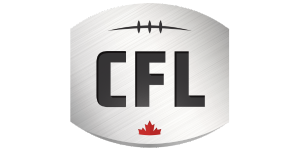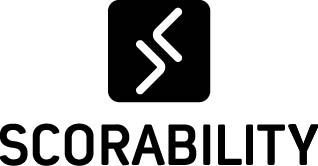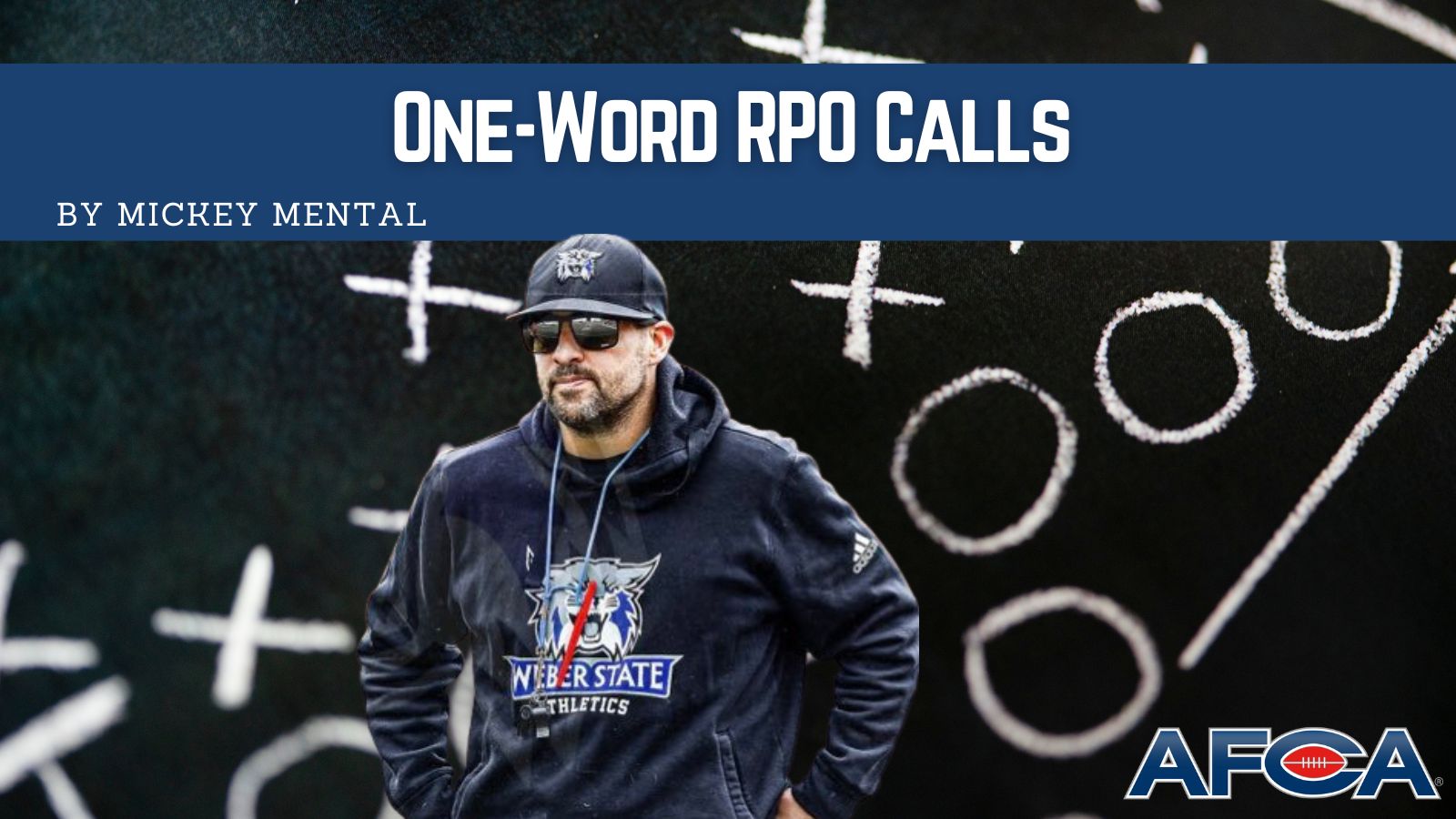
One-Word RPO Calls
April 11, 2023
Growing up in a coaching family, I have long been fascinated by the various ways to exploit a defense My father and two uncles were all high school head football coaches in Ohio, and being around the game-planning meetings and practices at a young age played a significant role in how I try to build my offense.
My knowledge of the game grew from playing quarterback over the years, which included film sessions with my head coach to go over the game plan for that week. While in high school, my coach and I would analyze the tape to determine the best way to take advantage of matchups in
both the run and pass game. It was a process that I looked forward to every week.
An integral piece of modern-day offenses that was not present in those days was the run/pass option (RPO) game. I was forced to learn about RPO while playing quarterback at Baldwin Wallace College, where I really started to fully comprehend its use entering my junior year.
Our offensive coordinator and quarterbacks coach then was Ian Shoemaker, who now holds both positions at Eastern Washington, and he implemented an RPO system. It allowed the offense the option to check out of a bad play and into a more efficient one to take advantage of the defense. With the RPO system in place, heavy at its core, we often centered it around a trigger read. In this read, we place a player within the offense in a position of conflict based on his leverage presnap and movement post-snap.
After my brief NFL playing career ended with the Cleveland Browns, I knew I wanted to coach. I was blessed with the opportunity to help launch the football program at Notre Dame College as a graduate assistant, where I assisted with the quarterbacks during my first season. In doing so, I wanted to incorporate what I learned at Baldwin Wallace into our new offense at Notre Dame College.
As a former quarterback, of course, I love to throw the football. But as a first-year program, I knew it would be best to keep things simple because most of our players were incoming freshmen. RPO allows your offense to get the ball out quickly, which decreases the chances of taking negative yardage plays but also keeps it in a rhythm.
Under Shoemaker at Baldwin Wallace, our top RPO option was an inside zone read married with either a two-man or three-man bubble. Taking that base, we built our offensive foundation at Notre Dame College around the inside zone/bubble look, which allowed us to control the box
and create a more efficient way to run the football. As an up-tempo offense, we would use this formation to call inside zone reads/belly plays quickly to take advantage of defenses.
At Notre Dame College, we created families for our one-word RPO plays. We used NFL, college, MLB and NBA teams to help the players translate each one-word call. By doing so, we are able to line up quickly and be more efficient with our top plays. To this day, the No. 1 play is
still inside zone/bubble.
Building The Formations To The RPO
As a 10-personnel team with no true tight end attached, we have had to get creative to find formations that we could line up in to run inside zone/bubble. Our initial focus was to secure a five-man box to run the ball first. But if there are more than five players in the box, we want to maintain the option to get the ball on the perimeter to one of our playmakers in space. Below are the formations we settled on to create our one-word inside zone/bubble/hitch series.
Formations
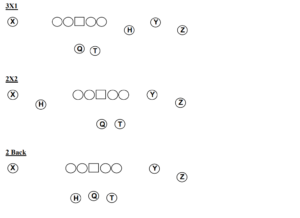
Philosophy & Design
When we initially designed our one-word RPO series, we wanted to have the ability to call it anywhere on the field in a way that is as seamless as possible. We can either run the series to the open field or have formation in the boundary. To pick up the speed, we have our outside wide
receiver play strictly on one side, while the tight end always goes to the right side of the field. Our adjuster in this setting is labeled “H,” while the running back is in a side-car alignment to the right on all formations within the series. The hitch and bubble concept allows us to accomplish our goal of getting the ball to the perimeter in space.
Rules in the system are the following:
1. Run Game: inside zone to the right
2. Hitch (fade) if press, always to the left
3. Three-man bubble always right
3×1 vs Two High (Six-Man Box)
In our 3×1 set, we are already in formation to run our three-man bubble play. In this setup, we do
not have to motion to get to a three-man bubble.
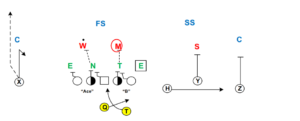
Quarterback Progression:
We teach our quarterbacks here to identify the boundary safety first pre-snap. In the above, with the free safety staying to the single-receiver side, we eliminate the hitch as our quarterback progresses to the bubble inside zone read. Since it is a three-man bubble concept, we will count three defenders inside eight yards. The Mike linebacker in the above is the conflict defender. His post-snap movement will decide if we will throw quickly or progress to the inside zone read. Given the appropriate leverage, the quarterback will throw the bubble.
Offensive Line:
Inside zone left.
Center: ID the Mike.
Play-Side Tackle: Block the first defender in his gap.
Play-Side Guard and Center: Make an “ace” call and double to plus-one on the Mike.
Backside Guard and Tackle: Make a “B” call and double to the Mike.
X Receiver: Hitch – Vertical release to six yards.
Route Adjustment: Against a press or a squat corner, convert to fade.
Z Receiver: Block man on.
Y Receiver: Block head up to inside defender.
H Receiver: Bubble – Open in run. Biggest point to remember here is the catch point, which is the heels of the outside receiver. By doing this, it gives the quarterback and receiver a catch point to be more efficient.
2×2 vs Three Roll Strong (Six-Man Box)
In our 2×2 set, we must motion our “H” receiver to the right to create a three-man bubble concept. The quarterback will get the formation set, sending the “H” in motion and our snap point is his alignment in our 3×1 formation.
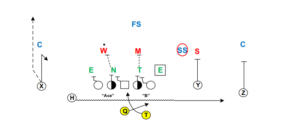
Quarterback Progression: Just like the first example, we teach our quarterbacks here to identify the boundary safety first pre-snap. In the picture above, with the free safety rotated to the middle of the field, the play shifts, creating a one-on-one situation to throw the hitch (if the cornerback is soft in alignment). On the snap of the ball, the quarterback will go straight to this route. If the defense moved late and we progress to the bubble concept, the quarterback’s trigger will be the strong safety, which would put him on his inside zone pull read.
Offensive Line: Inside Zone left.
Center: ID the Mike.
Play-Side Tackle: Block first defender in his gap.
Play-Side Guard and Center: Make an “Ace” call and double to plus-one of the Mike.
Backside Guard and Tackle: Make a “B” call and double to the Mike.
X Receiver: Hitch – Vertical release to six yards.
Route Adjustment: Against a press or a squat corner, convert to fade.
Z Receiver: Block man on.
Y Receiver: Block head up to inside defender.
H Receiver: Being in a 2×2 set, this receiver will go in motion and watch the movement of the outside receiver to start his bubble route. Like above, the catch point will remain the heels of the outside receiver.
2 Back vs Two High (Five-Man Box)
In our two-back set, we must motion our “H” receiver to the right side in order to create a three-man bubble concept. The motion we use here is called “burst.” The quarterback will get the formation set and send the “H” in motion behind the quarterback and running back alignment.
The snap point is when the quarterback sees the “H” out of the corner of his eye going in motion.
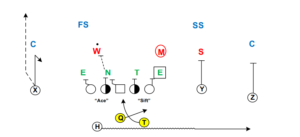
Quarterback Progression: Similar to the other sets, the quarterback here will identify the boundary safety pre-snap. In the picture above, the defense is in a two-high shell. With the free safety staying to the one receiver, the hitch is eliminated in the progression. The quarterback will
then progress to find the third defender for the bubble concept. In this instance, it would be the Mike, which would be leverage outside the box. If his first movement is to the “H” motion, the quarterback would go to his inside zone read.
Offensive Line: Inside Zone left.
Center: ID the Mike (OL will make a 4-1 call).
Play-Side Tackle: Block first defender in his gap.
Play-Side Guard and Center: Make an “Ace” call and double to plus-one of the Mike.
Backside Guard: Man on the three-technique.
Backside Tackle: With it being a 4-1 call, this player will execute a sift technique and block the B gap. If the Mike leaves the box, he will turn back on the end.
X Receiver: Hitch – Vertical release to six yards.
Route Adjustment: Against the press or a squat corner, convert to fade.
Z Receiver: Block man on.
Y Receiver: Block head up to inside defender.
H Receiver: Bubble – By being in a two-back formation, he will align away from the “Y.” He will start his motion toward the “Y” on the cadence. Once he goes in motion, we will look at the outside receiver. Once the outside receiver moves, he will bend down to his catch point for the
bubble.
Because I had to learn and embrace RPO quickly during my playing career, as a coach I have been able to install the system as simply as possible for my players. As shown in the aforementioned three formations, our RPO system is complex enough to create conflict for opposing defenses but also keeps it straightforward for our players. Most, if not all, offenses contain an RPO element to them these days, but by adding unique one-word calls to accompany simple formation tweaks, we are able to run an efficient offense that scores plenty of points.
For more information about the AFCA, visit www.AFCA.com. For more interesting articles, check out The Insider and subscribe to our weekly email.
If you are interested in more in-depth articles and videos, please become an AFCA member. You can find out more information about membership and specific member benefits on the AFCA Membership Overview page. If you are ready to join, please fill out the AFCA Membership Application.
« « Previous PostNext Post » »
Growing up in a coaching family, I have long been fascinated by the various ways to exploit a defense My father and two uncles were all high school head football coaches in Ohio, and being around the game-planning meetings and practices at a young age played a significant role in how I try to build my offense.
My knowledge of the game grew from playing quarterback over the years, which included film sessions with my head coach to go over the game plan for that week. While in high school, my coach and I would analyze the tape to determine the best way to take advantage of matchups in
both the run and pass game. It was a process that I looked forward to every week.
An integral piece of modern-day offenses that was not present in those days was the run/pass option (RPO) game. I was forced to learn about RPO while playing quarterback at Baldwin Wallace College, where I really started to fully comprehend its use entering my junior year.
Our offensive coordinator and quarterbacks coach then was Ian Shoemaker, who now holds both positions at Eastern Washington, and he implemented an RPO system. It allowed the offense the option to check out of a bad play and into a more efficient one to take advantage of the defense. With the RPO system in place, heavy at its core, we often centered it around a trigger read. In this read, we place a player within the offense in a position of conflict based on his leverage presnap and movement post-snap.
After my brief NFL playing career ended with the Cleveland Browns, I knew I wanted to coach. I was blessed with the opportunity to help launch the football program at Notre Dame College as a graduate assistant, where I assisted with the quarterbacks during my first season. In doing so, I wanted to incorporate what I learned at Baldwin Wallace into our new offense at Notre Dame College.
As a former quarterback, of course, I love to throw the football. But as a first-year program, I knew it would be best to keep things simple because most of our players were incoming freshmen. RPO allows your offense to get the ball out quickly, which decreases the chances of taking negative yardage plays but also keeps it in a rhythm.
Under Shoemaker at Baldwin Wallace, our top RPO option was an inside zone read married with either a two-man or three-man bubble. Taking that base, we built our offensive foundation at Notre Dame College around the inside zone/bubble look, which allowed us to control the box
and create a more efficient way to run the football. As an up-tempo offense, we would use this formation to call inside zone reads/belly plays quickly to take advantage of defenses.
At Notre Dame College, we created families for our one-word RPO plays. We used NFL, college, MLB and NBA teams to help the players translate each one-word call. By doing so, we are able to line up quickly and be more efficient with our top plays. To this day, the No. 1 play is
still inside zone/bubble.
Building The Formations To The RPO
As a 10-personnel team with no true tight end attached, we have had to get creative to find formations that we could line up in to run inside zone/bubble. Our initial focus was to secure a five-man box to run the ball first. But if there are more than five players in the box, we want to maintain the option to get the ball on the perimeter to one of our playmakers in space. Below are the formations we settled on to create our one-word inside zone/bubble/hitch series.
Formations

Philosophy & Design
When we initially designed our one-word RPO series, we wanted to have the ability to call it anywhere on the field in a way that is as seamless as possible. We can either run the series to the open field or have formation in the boundary. To pick up the speed, we have our outside wide
receiver play strictly on one side, while the tight end always goes to the right side of the field. Our adjuster in this setting is labeled “H,” while the running back is in a side-car alignment to the right on all formations within the series. The hitch and bubble concept allows us to accomplish our goal of getting the ball to the perimeter in space.
Rules in the system are the following:
1. Run Game: inside zone to the right
2. Hitch (fade) if press, always to the left
3. Three-man bubble always right
3×1 vs Two High (Six-Man Box)
In our 3×1 set, we are already in formation to run our three-man bubble play. In this setup, we do
not have to motion to get to a three-man bubble.

Quarterback Progression:
We teach our quarterbacks here to identify the boundary safety first pre-snap. In the above, with the free safety staying to the single-receiver side, we eliminate the hitch as our quarterback progresses to the bubble inside zone read. Since it is a three-man bubble concept, we will count three defenders inside eight yards. The Mike linebacker in the above is the conflict defender. His post-snap movement will decide if we will throw quickly or progress to the inside zone read. Given the appropriate leverage, the quarterback will throw the bubble.
Offensive Line:
Inside zone left.
Center: ID the Mike.
Play-Side Tackle: Block the first defender in his gap.
Play-Side Guard and Center: Make an “ace” call and double to plus-one on the Mike.
Backside Guard and Tackle: Make a “B” call and double to the Mike.
X Receiver: Hitch – Vertical release to six yards.
Route Adjustment: Against a press or a squat corner, convert to fade.
Z Receiver: Block man on.
Y Receiver: Block head up to inside defender.
H Receiver: Bubble – Open in run. Biggest point to remember here is the catch point, which is the heels of the outside receiver. By doing this, it gives the quarterback and receiver a catch point to be more efficient.
2×2 vs Three Roll Strong (Six-Man Box)
In our 2×2 set, we must motion our “H” receiver to the right to create a three-man bubble concept. The quarterback will get the formation set, sending the “H” in motion and our snap point is his alignment in our 3×1 formation.

Quarterback Progression: Just like the first example, we teach our quarterbacks here to identify the boundary safety first pre-snap. In the picture above, with the free safety rotated to the middle of the field, the play shifts, creating a one-on-one situation to throw the hitch (if the cornerback is soft in alignment). On the snap of the ball, the quarterback will go straight to this route. If the defense moved late and we progress to the bubble concept, the quarterback’s trigger will be the strong safety, which would put him on his inside zone pull read.
Offensive Line: Inside Zone left.
Center: ID the Mike.
Play-Side Tackle: Block first defender in his gap.
Play-Side Guard and Center: Make an “Ace” call and double to plus-one of the Mike.
Backside Guard and Tackle: Make a “B” call and double to the Mike.
X Receiver: Hitch – Vertical release to six yards.
Route Adjustment: Against a press or a squat corner, convert to fade.
Z Receiver: Block man on.
Y Receiver: Block head up to inside defender.
H Receiver: Being in a 2×2 set, this receiver will go in motion and watch the movement of the outside receiver to start his bubble route. Like above, the catch point will remain the heels of the outside receiver.
2 Back vs Two High (Five-Man Box)
In our two-back set, we must motion our “H” receiver to the right side in order to create a three-man bubble concept. The motion we use here is called “burst.” The quarterback will get the formation set and send the “H” in motion behind the quarterback and running back alignment.
The snap point is when the quarterback sees the “H” out of the corner of his eye going in motion.

Quarterback Progression: Similar to the other sets, the quarterback here will identify the boundary safety pre-snap. In the picture above, the defense is in a two-high shell. With the free safety staying to the one receiver, the hitch is eliminated in the progression. The quarterback will
then progress to find the third defender for the bubble concept. In this instance, it would be the Mike, which would be leverage outside the box. If his first movement is to the “H” motion, the quarterback would go to his inside zone read.
Offensive Line: Inside Zone left.
Center: ID the Mike (OL will make a 4-1 call).
Play-Side Tackle: Block first defender in his gap.
Play-Side Guard and Center: Make an “Ace” call and double to plus-one of the Mike.
Backside Guard: Man on the three-technique.
Backside Tackle: With it being a 4-1 call, this player will execute a sift technique and block the B gap. If the Mike leaves the box, he will turn back on the end.
X Receiver: Hitch – Vertical release to six yards.
Route Adjustment: Against the press or a squat corner, convert to fade.
Z Receiver: Block man on.
Y Receiver: Block head up to inside defender.
H Receiver: Bubble – By being in a two-back formation, he will align away from the “Y.” He will start his motion toward the “Y” on the cadence. Once he goes in motion, we will look at the outside receiver. Once the outside receiver moves, he will bend down to his catch point for the
bubble.
Because I had to learn and embrace RPO quickly during my playing career, as a coach I have been able to install the system as simply as possible for my players. As shown in the aforementioned three formations, our RPO system is complex enough to create conflict for opposing defenses but also keeps it straightforward for our players. Most, if not all, offenses contain an RPO element to them these days, but by adding unique one-word calls to accompany simple formation tweaks, we are able to run an efficient offense that scores plenty of points.
For more information about the AFCA, visit www.AFCA.com. For more interesting articles, check out The Insider and subscribe to our weekly email.
If you are interested in more in-depth articles and videos, please become an AFCA member. You can find out more information about membership and specific member benefits on the AFCA Membership Overview page. If you are ready to join, please fill out the AFCA Membership Application.
